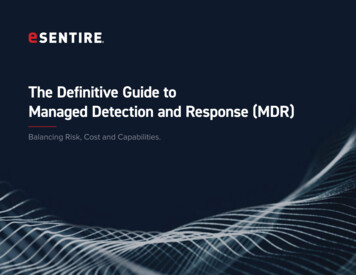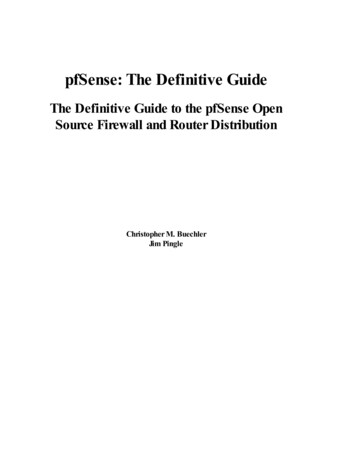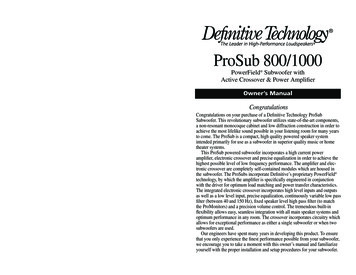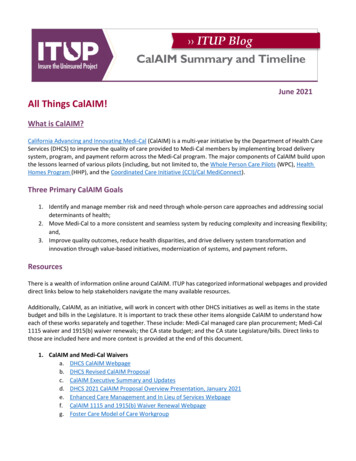
Transcription
The Definitive Guide toManaged Detection and Response (MDR)Balancing Risk, Cost and Capabilities.
Table of Contents358Introduction: From Concept to CriminalityThe Advent of Managed Detection and Response (MDR)Criteria for MDR Providers8Current market definitions8Spotting potential red flags10Technical criteria11 Visibility14 Signal fidelity16 Detection capabilities20 Response25Other criteria to consider29 Takeaways30Technical criteria summary32SOCaaS/Managed SIEM3538414447505354ED-little-r (single telemetry)MD-little-r (multiple telemetry)MD-little-r (full telemetry)ED-big-R (single telemetry)MD-big-R (multiple telemetry)MD-big-R (full telemetry)Summary and RecommendationsGlossary November 2019
The Seven Categories of Managed Detection and ResponseCriteria for Managed Detection and Response ProvidersCurrent MarketDefinitionsSpotting PotentialRed FlagsVisibilitySignal FidelityDetectionCapabilitiesResponseOther CriteriaSOCaaS/Managed SIEMED-little-rMD-little-r(Single Telemetry) (Multiple Telemetry)MD-little-r(Full Telemetry)ED-big-RMD-big-R(Single Telemetry) (Multiple Telemetry)MD-big-R(Full Telemetry)IntroductionFROM CONCEPT TO CRIMINALITYA first-mover advantage in chess is inherently enjoyed bythe player who opens the game, taking the upper hand withan offensive strategy, while forcing the opponent to adopt adefensive strategy. Much like chess, the history ofcybersecurity follows similar gameplay.Originally rooted in academia, cybersecurity soon took on adarker nature when criminals took an interest. In the late ‘80s,the Morris worm nearly wiped out the early internet; in doingso, it had the effect of spurring recognition of the potentialweaponization and monetization of cyberpower.1In 1971, a computer researcher named Bob Thomas createda program named Creeper, which moved betweenmainframe computers connected to the ARPANET andoutputted the message, “I’m the creeper: catch me ifyou can.”Fast forward to today: global cybersecurity spending willexceed 200 billion in 2019, and cybercrime is expected tocost 6 trillion annually by 2021.Intrigued by this idea, Ray Tomlinson (who invented emailthe same year) modified Creeper to replicate itself,rather than move itself, thereby creating the first self-replicatingworm. Subsequently, Tomlinson also created the firstantivirus program, Reaper, to chase and delete Creeper.As they say, the rest is history.1From the Morris worm of 1988 to the thousands of newexploits that now emerge on a daily basis each year,cyberattackers have demonstrated over the past three decadesprecision, skill and creativity in exploiting new technologiesand applications. With the first-mover advantage of time andcalculated execution, cyberattackers enjoy continued successdespite enormous investments in cyberdefenses.Named after its creator, Robert Tappan Morris, the Morris worm also resulted in the first felony conviction in the United States under the 1986 Computer Fraud and Abuse Act3
The Seven Categories of Managed Detection and ResponseCriteria for Managed Detection and Response ProvidersSpotting PotentialRed FlagsIntroductionCurrent MarketDefinitionsVisibilitySignal FidelityDetectionCapabilitiesResponseOther CriteriaSOCaaS/Managed SIEMED-little-rMD-little-r(Single Telemetry) (Multiple Telemetry)MD-little-r(Full Telemetry)MD-big-RED-big-R(Single Telemetry) (Multiple Telemetry)MD-big-R(Full Telemetry)Attackers enjoy a first-mover advantage, whether they bide their time or strike quickly. Despite largedefensive investments, particularly in prevention, breaches remain hidden longer and take longer tocontain than ever before, leading to significant real-world consequences for organizations.DEFENSIVE emediation4Post-Incident ResponseATTACKER SPEED31-5HOURS:15%5 - 10 HOURS: 20%10 - 15 HOURS: 19% 15 HOURS: 46%DEFENSIVE SPEED4Mean Time to Identifya Breach al Client Churn:3.4 %2019: 3.9 %2018: 3.92MPer Employee (SMBs): 3,533Cost Per Record: 150Average Cost of Breach:Ponemon (March 2018): Third Annual Study on the Cyber Resilient Organization2018 Nuix Black ReportPonemon: 2019 Cost of a Data Breach StudyDays to Containa Breach:2017:662018:692019:73234,54
The Seven Categories of Managed Detection and ResponseCriteria for Managed Detection and Response ProvidersCurrent MarketDefinitionsSpotting PotentialRed FlagsVisibilitySignal FidelityDetectionCapabilitiesResponseOther CriteriaSOCaaS/Managed SIEMED-little-rMD-little-r(Single Telemetry) (Multiple Telemetry)MD-little-r(Full Telemetry)ED-big-RMD-big-R(Single Telemetry) (Multiple Telemetry)MD-big-R(Full Telemetry)The Advent of Managed Detection and Response (MDR)Under-resourced, overextended and facing complications dueto distributed people, process and technology, cybersecurityteams often struggle with threat prevention, detection, responseand recovery activities.Historically, prevention commanded the largest allocation ofbudget and resources. However, as threat actors developedmore sophisticated attacks capable of bypassing preventativemeasures, the need for equal investment in detection andresponse capabilities became clear.Released in 2016, the inaugural Gartner Market Guide forManaged Detection and Response Services6 cited anemerging category of security service providers that “improvesthreat detection monitoring and incident response capabilitiesvia a turnkey approach to detecting threats that havebypassed other controls.”6Going back to as early as 2011, the concept of ManagedDetection and Response (MDR) represents an acknowledgmentthat prevention will fail in some instances. Risk mitigation isdependent upon how fast an attack can be detected, andmore importantly, contained and remediated before businessis disrupted.In this high stakes race against time, the threat detection andresponse challenge is exacerbated by digital transformation andmobility that have substantially expanded the attacksurface. What was once a defined perimeter is now a borderlessenvironment, which can span on-premises and cloud domains.With increased pressures from competitive markets,socioeconomic factors and regulatory consequences,security teams are looking for Security Operations Center (SOC)services to bolster internal capabilities with improveddetection and response.Gartner Market Guide for Managed Detection and Response Services, Toby Bussa, Craig Lawson, Kelly Kavanagh, Sid Deshpande, Craig Lawson, Pete Shoard, 10 May 20165
The Seven Categories of Managed Detection and ResponseCriteria for Managed Detection and Response ProvidersSpotting PotentialRed FlagsVisibilitySignal FidelityDetectionCapabilitiesResponseOther CriteriaSOCaaS/Managed SIEMED-little-rMD-little-r(Single Telemetry) (Multiple Telemetry)MD-little-r(Full Telemetry)ED-big-RMD-big-R(Single Telemetry) (Multiple Telemetry)MD-big-R(Full Telemetry)From prevention to modern threat management; over time, the mitigated risk has outpaced thetotal cost of solution ownership/investment, resulting in greater customer valueTOTAL COST OF OWNERSHIPMITIGATED RISKOPENRISKThe Advent of Managed Detection and Response (MDR)Current EDICTIVERESPONSEFirewalls AV SpamMSSPManaged SIEMManaged SIEMmigrating to MDRMDR HuntingMDR ML Dark Threat IntelligencePREVENTION TECHNOLOGY AND DEVICE MANAGEMENTPROACTIVE AND PREDICTIVE RESPONSEEarly stages of security services centered around preventionand leveraged firewalls, antivirus and patching as proxies forrisk management. As device numbers grew, organizationsoutsourced management of these devices, increasing scalebut falling short in mitigating risk.Ultimately, organizations recognized that achieving compliancealone does not equal effective cybersecurity. As a result,proactive and predictive threat management emerged.Both approaches leverage advanced technologies, includingartificial intelligence, to illuminate the most elusive threats, toreduce false positives and to predict cyberattackers’ next moves.ALERT MANAGEMENT AND ALERT RESPONSEAs the attack surface spread and regulatory consequencesgrew in severity, focus shifted to correlating signals andgenerating alerts that could be actioned quickly whilesatisfying compliance. Unfortunately, the majority of alertsresulted in longer incident dwell times due to lack of personneland the expertise to hunt, confirm and contain threats in atimely manner.Integrated response was the crucial factor in minimizing thedwell time of threat actors, alleviating the burden of staffingand operationalizing around-the-clock SOC.6
The Seven Categories of Managed Detection and ResponseCriteria for Managed Detection and Response ProvidersThe Advent of Managed Detection and Response (MDR)Current MarketDefinitionsSpotting PotentialRed FlagsVisibilitySignal FidelityDetectionCapabilitiesResponseOther CriteriaSOCaaS/Managed SIEMED-little-rMD-little-r(Single Telemetry) (Multiple Telemetry)MD-little-r(Full Telemetry)ED-big-RMD-big-R(Single Telemetry) (Multiple Telemetry)MD-big-R(Full Telemetry)A CROWDED, COMPLEX MARKETSPACEWhile MDR has been validated in necessity and efficacy,the marketplace for such services has become complex.Early-stage security organizations such as managed securityservice providers (MSSPs) and those providing managedSecurity Information and Event Management (SIEM) nowrecognize the opportunity and are pivoting messaging andservices to align with MDR. This growing contingent createsconfusion around what MDR is and should be.The original 2016 version of the Gartner Market Guidefor Managed Detection and Response Services cited 14organizations as being representative vendors. Just threeyears later, the 2019 edition states that “Gartner estimatesthat there are now over 100 providers visible in this marketclaiming to offer MDR services.” 7The lack of clear definition as to what constitutes MDR createsconfusion about the attributes that organizations should useto qualify and validate MDR delivery from a potential provider.While no singular definition can yet be established, a number ofclear categories that exist at the intersections of different levelsof risk mitigation and cost have emerged.This guide objectively defines the seven categories of MDRand explores their associated strengths and weaknesses.The goal is to help organizations make an informed choicethat aligns with their business objectives, security resourcesand risk tolerance.THE SEVEN CATEGORIES OF MDR:SOCaaS/Managed SIEMED-little-r (Single Telemetry)MD-little-r (Multiple Telemetry)MD-little-r (Full Telemetry)ED-big-R (Single Telemetry)MD-big-R (Multiple Telemetry)MD-big-R (Full Telemetry)7Gartner Market Guide for Managed Detection and Response Services, Toby Bussa, Kelly Kavanagh, Sid Deshpande, Craig Lawson, Pete Shoard, 15 July 20197
The Seven Categories of Managed Detection and ResponseCriteria for Managed Detection and Response ProvidersCurrent MarketDefinitionsSpotting PotentialRed FlagsVisibilitySignal FidelityDetectionCapabilitiesResponseOther CriteriaSOCaaS/Managed SIEMED-little-rMD-little-r(Single Telemetry) (Multiple Telemetry)MD-little-r(Full Telemetry)ED-big-RMD-big-R(Single Telemetry) (Multiple Telemetry)MD-big-R(Full Telemetry)Criteria for Managed Detection and Response ProvidersCURRENT MARKET DEFINITIONSMany analyst firms have released reports or guides thatinclude broad category definitions of MDR providers.Many of these publications also list and discuss providerattributes to assist organizations with choosing an appropriatesolution. Most recently, the 2019 edition of Gartner’s MarketGuide for Managed Detection and Response Servicescategorized providers into four general styles, based upon“technology stacks:” Full stack from the provider Managed point solutions: Endpoint Detection andResponse (EDR) and Network Detection and Response (NDR) Bring your own (BYO) technology stack Technologies for other environments and assets likecloud and devices: Infrastructure as a Service (IaaS),Security as a Service (SaaS), Operational Technology (OT)and Internet of Things (IoT) and Industrial Internet of Things(IIoT) devicesdefine technical criteria by which any MDR provider can beobjectively and functionally assessed, let’s briefly examineorganizational factors that can be used to initially qualifypotential MDR providers.SPOTTING POTENTIAL RED FLAGSWith over 100 MDR providers now being tracked in themarketplace, backgrounds differ vastly from provider toprovider. MSSPs have evolved their offerings, softwareproviders have added a managed component, consultantshave added technology stacks and other players werefounded as pure-play MDR providers.While background alone does not qualify or disqualify aprovider’s capabilities, it does supply important context andis suggestive of a provider’s ability to meet an organization’sindividual security requirements.While these categories begin to distinguish between differentMDR service providers, they don’t stipulate the attributes thatdetermine a provider’s ability to deliver on the very purposeof MDR (i.e., minimizing threat actor dwell time). But before we8
The Seven Categories of Managed Detection and ResponseCriteria for Managed Detection and Response ProvidersSPOTTING POTENTIAL RED FLAGSCurrent MarketDefinitionsSpotting PotentialRed FlagsVisibilitySignal FidelityDetectionCapabilitiesResponseOther CriteriaSOCaaS/Managed SIEMED-little-rMD-little-r(Single Telemetry) (Multiple Telemetry)MD-little-r(Full Telemetry)ED-big-RMD-big-R(Single Telemetry) (Multiple Telemetry)MD-big-R(Full Telemetry)Outlined below are questions that should be asked of any potential MDR provider; the answers to whichprovide important information for subjectively assessing a provider’s qualifications and suitability.The answers to these questions will help you understand if MDR is a core competency of aparticular provider or more of a trendy and opportunistic addition to a non-specialized portfolio. From where does the company provide the service? What was the company’s original mission? Does the company have different levels of analysts? How has the company evolved over time?COMPANYPROFILE Does the company have specific response personnel? What is the company’s core competency? Is the company a market leader or a follower? What is the leadership team’s background?PEOPLE ANDSERVICEDELIVERY What markets does the company serve? D oes the company have dedicated threat intelligenceanalysts and researchers? For what positions has the company hired in the past? For what positions is the company currently hiring? Where are the new positions based? Is the company public or private? W ho are the company’s backers/investors,and what are their track records? W hat do employees say about the company?(Glassdoor is a useful resource in this regard.) Is the company profitable?FINANCIALSTRENGTH W hat do peer review sites such as Gartner Peer Insights,SpiceWorks, G2, etc. reveal about the company? W hat is the company’s commitment to—and investment in—research and development? H ow much of the company’s revenue isattributable to MDR? F or how long will the company remain financiallyviable without additional investment? W hat do searches on subreddits reveal for experiencesworking with or at the company?DEMONSTRATIONOF DELIVERYAND REVIEWS Does the company have case studies? I s the company clear about what they do andhow they will deliver? D oes the company have customer references andstatements attesting to delivery? D oes the company hold granted patents andintellectual property? W hat are the company’s client satisfaction scores,NPS and retention rates? W hat is the company’s history of service andproduct releases?INNOVATION D oes the service and product release historyindicate reactive response to cyberlandscapedevelopments or proactive anticipation ofemerging shifts? W hat are the backgrounds, specializationsand skillsets of the company’s developmentand engineering team? (LinkedIn is a usefulresource in this regard.) F or what percentage of the total employee basedo development and engineering account?9
The Seven Categories of Managed Detection and ResponseCriteria for Managed Detection and Response ProvidersCurrent MarketDefinitionsSpotting PotentialRed FlagsVisibilitySignal FidelityDetectionCapabilitiesResponseTECHNICAL CRITERIA:VISIBILITY, FIDELITY, DETECTION, RESPONSEOther CriteriaSOCaaS/Managed SIEMED-little-rMD-little-r(Single Telemetry) (Multiple Telemetry)MD-little-r(Full Telemetry)ED-big-RMD-big-RMD-big-R(Single Telemetry) (Multiple Telemetry)(Full Telemetry)This radar chart combines the four technical criteria.Beyond subjective organizational factors, it is important todefine objective technical criteria against which any MDRprovider can be measured.VISIBILITYTo create a framework for assessing and comparing MDRproviders, we will use four criteria:VisibilityDetection CapabilitiesDETECTIONCAPABILITYRESPONSESignal FidelityResponseThese criteria correspond to the primary purpose of MDR:minimizing threat actor dwell time.Using radar diagrams, these criteria are combined intoan informative summary that captures the capabilitiesof each MDR segment.SIGNALFIDELITY10
The Seven Categories of Managed Detection and ResponseCriteria for Managed Detection and Response ProvidersCurrent MarketDefinitionsSpotting PotentialRed FlagsVisibilitySignal FidelityDetectionCapabilitiesResponseOther CriteriaSOCaaS/Managed SIEMED-little-rMD-little-r(Single Telemetry) (Multiple Telemetry)MD-little-r(Full Telemetry)ED-big-RMD-big-R(Single Telemetry) (Multiple Telemetry)MD-big-R(Full Telemetry)VISIBILITYFrom applications to infrastructure, organizations areoperating on-premises, in the cloud or in both. What was oncea clearly defined defensive perimeter is now a shifting blend ofmobile users and cloud workloads. As a result, visibility into thedigital network is more critical than ever before.There are many ways visibility can be obtained. MDR providerstypically rely on telemetry from: Endpoints: process and event data Networks: NetFlow, metadata records, full packet captures(e.g., PCAP) Log Data: login events, detection events, etc. Cloud: data outside of logs, endpoints and vulnerabilitydata, for instance from cloud access security brokers(CASB) or cloud workload records Vulnerability Data: exposed common vulnerabilities andexposures, ports, etc.In the context of the cyber kill chain8, each telemetry source has core competencies, visibility andefficacy across the attack surface.VisibilityCore competencyExternal ReconLOGNETWORKENDPOINTCloud(Outside of Log)VulnerabilityBreadthThings in motionProcess visibilityVariableVulnerability visibility(Depends on configuration)(Depends on configuration)(Depends on configuration)(Depends on configuration)(Depends on configuration)(Depends on configuration)(Depends on configuration)(Depends on configuration)(Depends on configuration)(Depends on configuration)(Depends on configuration)(Depends on configuration)(Depends on configuration)(Depends on configuration)(Depends on configuration)(Depends on tallationInternal ReconCommand and ControlData CollectionExfiltrationThe kill chain was originally used as a military concept related to the structure of an attack; breaking or disrupting an opponent’s kill chain is a method of defense. Recently,the concept has been applied to cybersecurity.811
The Seven Categories of Managed Detection and ResponseCriteria for Managed Detection and Response ProvidersVISIBILITYCurrent MarketDefinitionsSpotting PotentialRed FlagsVisibilitySignal FidelityDetectionCapabilitiesResponseOther CriteriaAt a superficial glance, it appears that log and cloud dataprovide the greatest coverage; however, as we will see when weexplore signal fidelity, this appearance is deceiving.SOCaaS/Managed SIEMIn addition, organizations should take into account their own ortheir service providers’ ability to correlate data with telemetrythat is out of the service scope. Admittedly, this consideration istypically a balancing act between in-house resources and cost;however, correlation and corroboration will nonethelessbe required at some point for forensic investigation, confirmationof attacker presence, reduction of false positives and rootcause discovery.In reference to the radar chart, we can now populate the first axis,Visibility. While many variations can exist, to keep things simplethe range of options are condensed into three points that capturethe majority of MDR providers.MD-little-rMD-little-r(Full Telemetry)MD-big-RED-big-RMD-big-R(Single Telemetry) (Multiple Telemetry)(Full Telemetry)These three points capture the capabilities of the majorityof MDR providers.VISIBILITYMoreover, since attack surfaces vary widely, it’s important for organizations to keenly consider their particular attack surface whenevaluating potential MDR providers’ capabilities with respect tovisibility.For example, distributed environments require visibility into cloud,Internet of Things (IoT) devices, industrial IoT (IIoT)devices and industry-specific services (e.g., eDiscovery,patient records, trading terminals, etc.). And, all of theseenvironments and devices are potential attack vectors fromwhich signals must be drawn. In addition, visibility into thefull attack surface is required is to reduce dwell times bymonitoring all the places a threat actor might be hiding asblind spots serve as beachheads for attacks.ED-little-r(Single Telemetry) (Multiple Telemetry)Full Telemetry Regardless of Deployment ModelMultiple Telemetry Sources (Endpoint Network)Singular Telemetry GLE TELEMETRY: Typically endpoint or log only (logs arelimited if the source doesn’t alert, no news is potentially afalse indicator)MULTIPLE TELEMETRY: Typically endpoint and log or network, butmissing visibility to some degree across the entirety of the networkFULL TELEMETRY: Visibility across endpoint, log, network, cloud,vulnerability regardless of deployment model12
The Seven Categories of Managed Detection and ResponseCriteria for Managed Detection and Response ProvidersVISIBILITYCurrent MarketDefinitionsSpotting PotentialRed FlagsVisibilitySignal FidelityDetectionCapabilitiesResponseOther CriteriaSOCaaS/Managed SIEMED-little-rMD-little-r(Single Telemetry) (Multiple Telemetry)MD-little-r(Full Telemetry)ED-big-RMD-big-RMD-big-R(Single Telemetry) (Multiple Telemetry)(Full Telemetry)QUESTIONS AND CONSIDERATIONS:When examining the visibility capabilities of potential MDRvendors, organizations should ask: What does our environment look like today, and what will itlook like in the future? What technologies will give us appropriate visibility inthe context of our unique threat landscape? What additional resources (e.g., people, process,technology) do we require to take action oninformed decisions? Does the data integrate with our systems, therebymaking it possible or easier for investigation andforensic investigation? What industry-specific tools do we use that wemust secure? Do the technologies also give us the ability to swiftlycontain and respond to threats? What are the potential implications for regulatoryrequirements? Does the level of visibility help us meet our acceptablerisk tolerance and support our business objectives?13
The Seven Categories of Managed Detection and ResponseCriteria for Managed Detection and Response ProvidersCurrent MarketDefinitionsSpotting PotentialRed FlagsVisibilitySignal FidelityDetectionCapabilitiesResponseOther CriteriaSOCaaS/Managed SIEMED-little-rMD-little-r(Single Telemetry) (Multiple Telemetry)MD-little-r(Full Telemetry)ED-big-RMD-big-RMD-big-R(Single Telemetry) (Multiple Telemetry)(Full Telemetry)SIGNAL FIDELITYWhen law enforcement investigates a crime different evidenceprovides different information that leads to various degrees ofconfidence to reach a conclusion, such as: DNA provides an in-depth level ofevidence that cannot reasonably be refuted Eyewitness testimony is much less reliable Video surveillance is somewhere in the middle: usefulin some circumstances but not without blind spotsThe deeper the level of evidence—the fidelity—the moreempowered analysts are to detect, hunt and confirm threatactor presence.Visibility and fidelity are closely, but typically inversely, related.Log data provides broad-level visibility but is limited in depth,whereas full packet captures from the network provide deepfidelity but are limited in breadth of scope. Importantly,each has strengths and weaknesses when applied to theinvestigative process.Building upon the previous chart, we see that the depth to which different telemetry sources provide information varies.VisibilityOverall depth of visibilityCore competencyExternal ReconLOGNETWORKENDPOINTCloud(Outside of Log)VulnerabilityLowHighHighHighLowBreadthThings in motionProcess visibilityVariableVulnerability visibility(Depends on configuration)(Depends on configuration)(Depends on configuration)(Depends on configuration)(Depends on configuration)(Depends on configuration)(Depends on configuration)(Depends on configuration)(Depends on configuration)(Depends on configuration)(Depends on configuration)(Depends on configuration)(Depends on configuration)(Depends on configuration)(Depends on configuration)(Depends on tallationInternal ReconCommand and ControlData CollectionExfiltration14
The Seven Categories of Managed Detection and ResponseCriteria for Managed Detection and Response ProvidersSIGNAL FIDELITYCurrent MarketDefinitionsSpotting PotentialRed FlagsVisibilitySignal FidelityDetectionCapabilitiesResponseWhen analyzing potential MDR providers, organizations shouldconcurrently consider both the visibility they provide andthe depth of that visibility. For instance, stepping once againthrough different telemetry sources:Other CriteriaSOCaaS/Managed SIEMED-little-rMD-little-r(Single Telemetry) (Multiple Telemetry)MD-little-r(Full Telemetry)ED-big-RMD-big-RMD-big-R(Single Telemetry) (Multiple Telemetry)(Full Telemetry)These three points capture the capabilities of themajority of MDR provider.VISIBILITY Network: NetFlow or PCAP? Or both? Log: What APIs are available? Cloud: What data is being pulled besides logs? How is thedata obtained (e.g., asset and service discovery, accessmanagement, data exfiltration, policy violations, etc.)?Full Telemetry Regardless of Deployment ModelMultiple Telemetry Sources (Endpoint Network) Vulnerability: What are the scope and limitations acrosscloud, mobile, IT, IoT, IIoT? Endpoint: What level of data is being pulled? Is it down tothe process and binary level?In reference to the radar chart, we now have the second axis.To keep things simplified, three points represent the majority ofMDR providers that can be plotted:LOW LEVEL: Collection of high level data only, includingNetFlow or logsSingular Telemetry SourceDETECTIONCAPABILITYRESPONSELow Level (ex. Log, NetFlow)Medium Level (ex. Full telemetry in some, limited in others)High Level (ex. Full endpoint, PCAP, Log, Vulnerability, etc.)MEDIUM LEVEL: Deep information from some sources(e.g., process and binary level from endpoint) but limitedinformation from others (e.g., NetFlow only from network or logs)HIGH LEVEL: Collection of full visibility depth including NetFlow,PCAP, full endpoint, vulnerability, log, etc.SIGNALFIDELITYQUESTIONS AND CONSIDERATIONS:When examining the signal fidelity capabilities of potential MDR vendors, organizations should ask: Given our contextual threat landscape, what level of data is required to complete a thorough investigation of potential threats? Does the provider have the appropriate technologies and resources to ingest the data, normalize it and correlateto arrive at informed decisions quickly? Do we have the resources in place to make sense of the data from the provider and to action accordingly?15
The Seven Categories of Managed Detection and ResponseCriteria for Managed Detection and Response ProvidersCurrent MarketDefinitionsSpotting PotentialRed FlagsVisibilitySignal FidelityDetectionCapabilitiesResponseOther CriteriaSOCaaS/Managed SIEMED-little-rMD-little-r(Single Telemetry) (Multiple Telemetry)MD-little-r(Full Telemetry)ED-big-RMD-big-RMD-big-R(Single Telemetry) (Multiple Telemetry)(Full Telemetry)DETECTION CAPABILITIESHunting, machine learning, automation, customized threatintelligence, behavioral, known, unknowns, zero-days thanksto the ingenuity of security researchers and the persistenceof attackers, the list of detection capabilities and related threatsis endless.Ultimately, the detection capabilities axis is the hardest to discernbetween fact and fiction when assessing MDR providers. Examiningboth the traditional MSSP and the emergent MDR marketplacesreveals an abundance of buzzwords pertaining to the latesttechnologies and newest threats.Without a proof of concept over an extended period, organizationsvetting potential vendors must ask the right questions and shouldseek demonstrable proof of delivery.To continue building the radar framework, a simplified spectrumof detection capabilities, starting from very basic detection andextending to advanced functionality that can detect evenunknown threats, must be created.Whether to detect insiders or malicious actors living off the land,signatures and indicators of compromise (IOCs) have becometable stakes. It’s the capability to find signals within the noisethat separates advanced detection capabilities.While important in the detection process, these technologiesare tools to achieve scale, rather than techniques that provideadditional detection capabilities per se. Consider theanalogy of trying to drive a nail into an object: a hammer isjust as effect
that aligns with their business objectives, security resources and risk tolerance. 7 Gartner Market Guide for Managed Detection and Response Services, Toby Bussa, Kelly Kavanagh, Sid Deshpande, Craig Lawson, Pete Shoard, 15 July 2019











